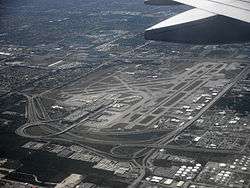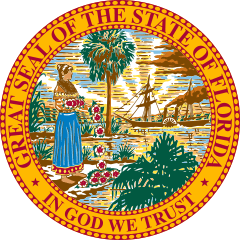Fort Lauderdale, Florida
Fort Lauderdale (/ˈlɔːdərdeɪl/) is a city in the U.S. state of Florida, 25 miles (40 km) north of Miami. It is the county seat of Broward County. As of the 2019 census, the city has an estimated population of 182,437.[11] Fort Lauderdale is a principal city of the Miami metropolitan area, which was home to an estimated 6,198,782 people in 2018.[12]
Fort Lauderdale, Florida | |
|---|---|
| City of Fort Lauderdale-Hollywood | |
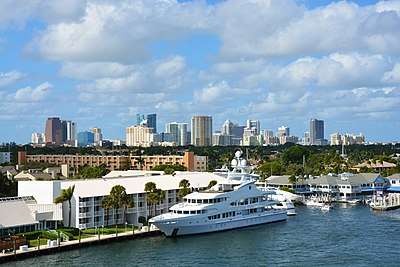 Downtown Fort Lauderdale | |
 Flag 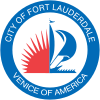 Seal | |
| Nickname(s): Venice of America | |
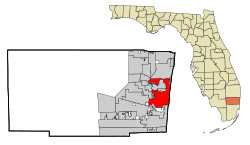 | |
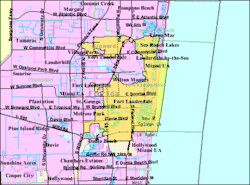 U.S. Census Bureau map | |
 Fort Lauderdale Location in Florida and the United States  Fort Lauderdale Fort Lauderdale (the United States) | |
| Coordinates: 26°8′N 80°9′W | |
| Country | |
| State | |
| County | Broward |
| Established | March 27, 1911 |
| Government | |
| • Type | Commission-Manager |
| • Mayor | Dean Trantalis (D) |
| • Vice Mayor | Ben Sorensen[1] |
| • Commissioners | Heather Moraitis, Robert L. McKinzie, Steven Glassman[2][3] |
| • City Manager | Christopher Lagerbloom[2][4] |
| • City Clerk | Jeffrey A. Modarelli[2][5] |
| Area | |
| • City | 36.30 sq mi (94.01 km2) |
| • Land | 34.59 sq mi (89.58 km2) |
| • Water | 1.71 sq mi (4.44 km2) 9.87% |
| Elevation | 9 ft (2.75 m) |
| Population (2010) | |
| • City | 165,521 |
| • Estimate (2019)[8] | 182,437 |
| • Density | 5,274.88/sq mi (2,036.64/km2) |
| • Metro | 5,762,717 (US: 8th) |
| Time zone | UTC−5 (Eastern (EST)) |
| • Summer (DST) | UTC−4 (EDT) |
| ZIP codes | 33301, 33304-33306, 33308-33309, 33312-33313, 33315-33316, 33334, 33394[9] |
| Area code(s) | 754, 954 |
| FIPS code | 12-24000 |
| GNIS feature ID | 0282693[10] |
| Website | www |
The city is a popular tourist destination, with an average year-round temperature of 75.5 °F (24.2 °C) and 3,000 hours of sunshine per year. Greater Fort Lauderdale, encompassing all of Broward County, hosted 13 million overnight visitors in 2018. There were over 560 hotels, and nearly 36,000 hotel rooms. From that, the county collected nearly $87 million from its 5% hotel development tax it charges. Additionally, 3.89 million cruise passengers passed through its Port Everglades, making it the 3rd largest cruise port in the world.[13] Greater Fort Lauderdale has over 4,000 restaurants, 63 golf courses, 12 shopping malls, 16 museums, 132 nightclubs, 278 parkland campsites, and 100 marinas housing 45,000 resident yachts.[14]
Fort Lauderdale is named after a series of forts built by the United States during the Second Seminole War. The forts took their name from Major William Lauderdale (1782–1838), younger brother of Lieutenant Colonel James Lauderdale. William Lauderdale was the commander of the detachment of soldiers who built the first fort.[15] Development of the city did not begin until 50 years after the forts were abandoned at the end of the conflict.
Three forts named "Fort Lauderdale" were constructed: the first was at the fork of the New River, the second was at Tarpon Bend on the New River between the present-day Colee Hammock and Rio Vista neighborhoods, and the third was near the site of the Bahia Mar Marina.[15]
History
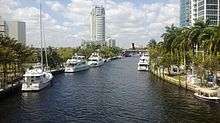
The area in which the city of Fort Lauderdale would later be founded was inhabited for more than two thousand years by the Tequesta Indians.[16] Contact with Spanish explorers in the 16th century proved disastrous for the Tequesta, as the Europeans unwittingly brought with them diseases, such as smallpox, to which the native populations possessed no resistance. For the Tequesta, disease, coupled with continuing conflict with their Calusa neighbors, contributed greatly to their decline over the next two centuries.[17] By 1763, there were only a few Tequesta left in Florida, and most of them were evacuated to Cuba when the Spanish ceded Florida to the British in 1763, under the terms of the Treaty of Paris (1763), which ended the Seven Years' War.[16] Although control of the area changed between Spain, United Kingdom, the United States, and the Confederate States of America, it remained largely undeveloped until the 20th century.
The Fort Lauderdale area was known as the "New River Settlement" before the 20th century. In the 1830s there were approximately 70 settlers living along the New River. William Cooley, the local Justice of the Peace, was a farmer and wrecker, who traded with the Seminole Indians. On January 6, 1836, while Cooley was leading an attempt to salvage a wrecked ship, a band of Seminoles attacked his farm, killing his wife and children, and the children's tutor. The other farms in the settlement were not attacked, but all the white residents in the area abandoned the settlement, fleeing first to the Cape Florida Lighthouse on Key Biscayne, and then to Key West.[18]
The first United States stockade named Fort Lauderdale was built in 1838,[19] and subsequently was a site of fighting during the Second Seminole War. The fort was abandoned in 1842, after the end of the war, and the area remained virtually unpopulated until the 1890s. It was not until Frank Stranahan arrived in the area in 1893 to operate a ferry across the New River, and the Florida East Coast Railroad's completion of a route through the area in 1896, that any organized development began. The city was incorporated in 1911, and in 1915 was designated the county seat of newly formed Broward County.[20]
Fort Lauderdale's first major development began in the 1920s, during the Florida land boom.[21] The 1926 Miami Hurricane[22] and the Great Depression of the 1930s caused a great deal of economic dislocation. In July 1935, an African-American man named Rubin Stacy was accused of robbing a white woman at knife point. He was arrested and being transported to a Miami jail when police were run off the road by a mob. A group of 100 white men proceeded to hang Stacy from a tree near the scene of his alleged robbery. His body was riddled with some twenty bullets.[23] The murder was subsequently used by the press in Nazi Germany to discredit U.S. critiques of its own persecution of Jews, Communists, and Catholics.[24]
When World War II began, Fort Lauderdale became a major U.S. base, with a Naval Air Station to train pilots, radar operators, and fire control operators. A Coast Guard base at Port Everglades was also established.[25]
Until July 1961 only whites were allowed on Ft. Lauderdale beaches. There were no beaches for African-Americans in Broward County until 1954, when "the Colored Beach", today Dr. Von D. Mizell-Eula Johnson State Park, was opened in Dania Beach; however, no road was built to it until 1965. On July 4, 1961, African Americans started a series of wade-ins as protests at beaches that were off-limits to them, to protest "the failure of the county to build a road to the Negro beach".[26]:30[27] On July 11, 1962 a verdict by Ted Cabot went against the city's policy of racial segregation of public beaches, and Broward County beaches were desegregated in 1962.
Today, Fort Lauderdale is a major yachting center,[28] one of the nation's largest tourist destinations,[28] and the center of a metropolitan division with 1.8 million people.[29]
Population size
After the war ended, service members returned to the area, spurring an enormous population explosion that dwarfed the 1920s boom.[17] The 1960 Census counted 83,648 people in the city, about 230% of the 1950 figure.[30] A 1967 report estimated that the city was approximately 85% developed,[31] and the 1970 population figure was 139,590.[32]
After 1970, as Fort Lauderdale became essentially built out, growth in the area shifted to suburbs to the west. As cities such as Coral Springs, Miramar, and Pembroke Pines experienced explosive growth, Fort Lauderdale's population stagnated, and the city actually shrank by almost 4,000 people between 1980, when the city had 153,279 people,[33] and 1990, when the population was 149,377. A slight rebound brought the population back up to 152,397 at the 2000 census. Since 2000, Fort Lauderdale has gained slightly over 18,000 residents through annexation of seven neighborhoods in unincorporated Broward County.[34]
Geography
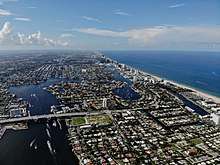
.jpg)
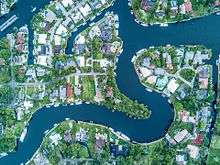
Location
According to the United States Census Bureau, the city has a total area of 38.6 square miles (99.9 km2), 34.7 square miles (90.0 km2) of which is land and 3.8 square miles (9.9 km2) of which is water (9.87%).[35] Fort Lauderdale is known for its extensive network of canals; there are 165 miles (266 km) of waterways within the city limits.[36]
The city of Fort Lauderdale is adjacent to the Atlantic Ocean, includes 7 miles (11 km) of beaches,[37] and borders the following municipalities:
On its east:
On its south:
On its southwest:
On its west:
On its northwest:
On its north:
The northwestern section of Fort Lauderdale is separate from the remainder of the city, connected only by the Cypress Creek Canal as it flows under I-95. This section of Fort Lauderdale borders the cities of Tamarac and Oakland Park on its south side. Oakland Park also borders Fort Lauderdale on the west side of its northeastern portion. The greater portion of Fort Lauderdale in the south is bordered, along its north side by Wilton Manors.
Off the coast of Fort Lauderdale is the Osborne Reef, an artificial reef made of discarded tires that has proven to be an ecological disaster.[38] The dumping began in the 1960s, with the intent to provide habitat for fish while disposing of trash from the land. In the rugged and corrosive environment of the ocean, however, nylon straps used to secure the tires wore out, cables rusted, and tires broke free. The tires posed a particular threat after breaking free from their restraints. The tires then migrated shoreward and ran into a living reef tract, washed up on its slope and killed many things in their path. In recent years, thousands of tires have also washed up on nearby beaches, especially during hurricanes. Local authorities are now working to remove the 700,000 tires, in cooperation with the U.S. Army, Navy and Coast Guard.[39]
Neighborhoods
Fort Lauderdale has a program for designating and recognizing neighborhoods. Under the Neighborhood Organization Recognition Program,[40] more than 60 distinct neighborhoods have received official recognition from the city. An additional 25–30 neighborhoods exist without official recognition, although the city's neighborhood map displays them as well.[41]
Climate
According to the Köppen climate classification, Fort Lauderdale has a trade-wind[42] tropical rainforest (Köppen Af).[43] While the city does not have a true dry season, much of the seasonal rainfall comes between May and October. Winters are frequently dry and sunny, and drought can be a concern in some years. (see climate chart below).
The wet season runs from May through October, and weather is typically hot, humid, and wet with average high temperatures of 86–90 °F (30–32 °C) and lows of 71–76 °F (22–24 °C). During this period, more than half of summer days may bring brief afternoon or evening thunderstorms with lightning and bursts of intense rainfall.[44] The record high temperature of 100 °F (38 °C) was recorded on June 22, 2009.[45]
The dry season often arrives some time in November and lasts through early to mid April. Sensible weather is often warm, dry, and sunny. Average high temperatures of 75–82 °F (24–28 °C) and lows of 59–67 °F (15–19 °C) are typical in the dry season. On rare occasion, cool fronts may make it all the way south to Ft. Lauderdale and the city will see a day or two of highs in the 60s °F (16-21 °C) and lows in the 40s °F (4-10 °C).[44] Rare frosts occur every few decades, and only once in reported history have snow flurries been reported in the air ;– on January 19, 1977.[46][47] During the dry season (winter), brush fires can be a concern in many years.
Annual average precipitation is 64.2 inches (1,630 mm), with most of it occurring during the wet season from May through October. However, rainfall occurs in all months, even during the drier months from November through April. Fort Lauderdale has an average of 143 rain days and 250 sunshine days annually. The hurricane season is between June 1 and November 30 with major hurricanes most likely to affect the city or state in September and October.[48] The most recent storms to directly affect the city were Hurricane Irma, in 2017,[49] Hurricane Katrina and Hurricane Wilma, both of which struck the city in 2005. Other direct hits were Hurricane Cleo in 1964, Hurricane King in 1950, and the 1947 Fort Lauderdale Hurricane.
Climate data for Fort Lauderdale–Hollywood International Airport, Florida (1981–2010 normals,[lower-alpha 1] extremes 1912–present) | |||||||||||||
|---|---|---|---|---|---|---|---|---|---|---|---|---|---|
| Month | Jan | Feb | Mar | Apr | May | Jun | Jul | Aug | Sep | Oct | Nov | Dec | Year |
| Record high °F (°C) | 92 (33) |
94 (34) |
94 (34) |
96 (36) |
97 (36) |
100 (38) |
99 (37) |
100 (38) |
99 (37) |
95 (35) |
91 (33) |
90 (32) |
100 (38) |
| Mean maximum °F (°C) | 83.8 (28.8) |
85.7 (29.8) |
87.6 (30.9) |
89.6 (32.0) |
91.7 (33.2) |
93.5 (34.2) |
94.0 (34.4) |
94.0 (34.4) |
92.6 (33.7) |
90.6 (32.6) |
86.8 (30.4) |
84.7 (29.3) |
95.1 (35.1) |
| Average high °F (°C) | 76.3 (24.6) |
77.7 (25.4) |
79.8 (26.6) |
82.7 (28.2) |
86.2 (30.1) |
88.8 (31.6) |
90.3 (32.4) |
90.4 (32.4) |
88.9 (31.6) |
85.9 (29.9) |
81.6 (27.6) |
77.9 (25.5) |
83.9 (28.8) |
| Average low °F (°C) | 61.6 (16.4) |
64.0 (17.8) |
66.0 (18.9) |
69.7 (20.9) |
74.2 (23.4) |
77.4 (25.2) |
78.3 (25.7) |
78.8 (26.0) |
77.5 (25.3) |
75.2 (24.0) |
69.5 (20.8) |
64.1 (17.8) |
71.4 (21.9) |
| Mean minimum °F (°C) | 41.6 (5.3) |
45.0 (7.2) |
48.9 (9.4) |
55.9 (13.3) |
64.9 (18.3) |
70.2 (21.2) |
71.3 (21.8) |
71.8 (22.1) |
71.5 (21.9) |
63.0 (17.2) |
53.6 (12.0) |
44.6 (7.0) |
38.4 (3.6) |
| Record low °F (°C) | 28 (−2) |
28 (−2) |
32 (0) |
40 (4) |
49 (9) |
57 (14) |
64 (18) |
66 (19) |
61 (16) |
46 (8) |
35 (2) |
29 (−2) |
28 (−2) |
| Average rainfall inches (mm) | 3.63 (92) |
2.96 (75) |
3.36 (85) |
2.89 (73) |
4.65 (118) |
10.16 (258) |
5.98 (152) |
7.44 (189) |
8.59 (218) |
6.82 (173) |
3.24 (82) |
2.46 (62) |
62.18 (1,579) |
| Average rainy days (≥ 0.01 in) | 5.0 | 6.1 | 6.9 | 5.4 | 8.8 | 15.9 | 15.9 | 15.7 | 15.8 | 10.6 | 8.1 | 8.1 | 122.3 |
| Source: NOAA[50][51][52] | |||||||||||||
Demographics
| Historical population | |||
|---|---|---|---|
| Census | Pop. | %± | |
| 1900 | 91 | — | |
| 1910 | 336 | 269.2% | |
| 1920 | 2,257 | 571.7% | |
| 1930 | 8,668 | 284.0% | |
| 1940 | 17,996 | 107.6% | |
| 1950 | 36,328 | 101.9% | |
| 1960 | 83,648 | 130.3% | |
| 1970 | 139,122 | 66.3% | |
| 1980 | 153,279 | 10.2% | |
| 1990 | 149,238 | −2.6% | |
| 2000 | 152,397 | 2.1% | |
| 2010 | 165,521 | 8.6% | |
| Est. 2019 | 182,437 | [8] | 10.2% |
| U.S. Decennial Census[53] | |||
| Fort Lauderdale Demographics | |||
|---|---|---|---|
| 2010 Census | Fort Lauderdale | Broward County | Florida |
| Total population | 165,521 | 1,748,066 | 18,801,310 |
| Population, percent change, 2000 to 2010 | +8.6% | +7.7% | +17.6% |
| Population density | 4,761.1/sq mi | 1,444.9/sq mi | 350.6/sq mi |
| White or Caucasian (including White Hispanic) | 62.6% | 63.1% | 75.0% |
| (Non-Hispanic White or Caucasian) | 52.5% | 43.5% | 57.9% |
| Black or African-American | 31.0% | 26.7% | 16.0% |
| Hispanic or Latino (of any race) | 13.7% | 25.1% | 22.5% |
| Asian | 1.5% | 3.2% | 2.4% |
| Native American or Native Alaskan | 0.3% | 0.3% | 0.4% |
| Pacific Islander or Native Hawaiian | 0.1% | 0.1% | 0.1% |
| Two or more races (Multiracial) | 2.1% | 2.9% | 2.5% |
| Some Other Race | 2.4% | 3.7% | 3.6% |
.png)
As of 2010, those of Hispanic or Latino ancestry accounted for 13.7% of Fort Lauderdale's population. Out of the 13.7%, 2.5% were Cuban, 2.3% Puerto Rican, 1.7% Mexican, 1.1% Colombian, 0.9% Guatemalan, 0.8% Salvadoran, 0.6% Honduran, and 0.6% were Peruvian.[54]
As of 2010, those of African ancestry accounted for 31.0% of Fort Lauderdale's population, which includes African Americans. Out of the 31.0%, 10.0% were West Indian or Afro-Caribbean American (6.4% Haitian, 2.5% Jamaican, 0.4% Bahamian, 0.2% Other or Unspecified West Indian, 0.2% British West Indian, 0.1% Trinidadian and Tobagonian, 0.1% Barbadian), 0.6% were Black Hispanics, and 0.5% were Subsaharan African.[54][55][56]
As of 2010, those of (non-Hispanic white) European ancestry accounted for 52.5% of Fort Lauderdale's population. Out of the 52.5%, 10.3% were Irish, 10.1% German, 8.1% Italian, 7.1% English, 3.0% Polish, 2.1% French, 1.9% Russian, 1.7% Scottish, 1.2% Scotch-Irish, 1.0% Dutch, 1.0% Swedish, 0.6% Greek, 0.6% Hungarian, 0.5% Norwegian, and 0.5% were French Canadian.[55][56]
As of 2010, those of Asian ancestry accounted for 1.5% of Fort Lauderdale's population. Out of the 1.5%, 0.4% were Indian, 0.3% Filipino, 0.3% Other Asian, 0.2% Chinese, 0.1% Vietnamese, 0.1% Japanese, and 0.1% were Korean.[55]
As of 2010, 0.6% were of Arab ancestry.[55]
In 2010, 7.1% of the population considered themselves to be of only American ancestry (regardless of race or ethnicity).[55][56]
As of 2010, there were 74,786 occupied households, while 19.7% were vacant. 17.7% had children under the age of 18 living with them, 30.4% were married couples living together, 12.3% have a female head of household with no husband present, and 52.4% were non-families. 39.4% of all households were made up of individuals, and 11.1% had someone living alone who was 65 years of age or older (4.8% male and 6.3% female.) The average household size was 2.17 and the average family size was 3.00.[55][57]
In 2010, the city population was spread out, with 17.6% under the age of 18, 8.1% from 18 to 24, 28.4% from 25 to 44, 30.6% from 45 to 64, and 15.3% who were 65 years of age or older. The median age was 42.2 years. For every 100 females, there were 111.8 males. For every 100 females age 18 and over, there were 113.1 males.[55][57]
As of 2010, the median income for a household in the city was $49,818, and the median income for a family was $59,238. Males had a median income of $46,706 versus $37,324 for females. The per capita income for the city was $35,828. About 13.1% of families and 18.2% of the population were below the poverty line, including 30.3% of those under age 18 and 12.5% of those aged 65 or over.[58]
In 2010, 21.3% of the city's population was foreign-born. Of foreign-born residents, 69.6% were born in Latin America and 15.3% were born in Europe, with smaller percentages from North America, Africa, Asia, and Oceania.[56]
In 2000, Fort Lauderdale had the twenty-sixth highest percentage of Haitian residents in the US, at 6.9% of the city's population,[59] and the 127th highest percentage of Cuban residents, at 1.7% of the city's residents.[60]
Like South Florida in general, Fort Lauderdale has many residents who can speak languages other than English, although its proportion is lower than the county average.[61] As of 2000, 75.63% of the population spoke only English at home, while 24.37% spoke other first languages. Speakers of Spanish were 9.43%, French Creole (mostly Haitian Creole) 7.52%, French 2.04%, Portuguese 1.02%, Italian 0.82%, and German at 0.80%.[62]
The city, along with adjacent small cities Oakland Park and Wilton Manors, is known for its large LGBT community and has one of the highest ratios of gay men and lesbians, with gay men being more largely present,[63] in the United States.[64] The city is also known as a popular vacation spot for gays and lesbians,[65] with many LGBT or LGBT-friendly hotels and guesthouses.[66] Fort Lauderdale hosts the Stonewall Library & Archives, and in neighboring Wilton Manors there is a large LGBT community center, the Pride Center, and the World AIDS Museum and Educational Center. The current Mayor of Fort Lauderdale, Dean Trantalis, is the first openly gay person to hold this office.[67]
Economy
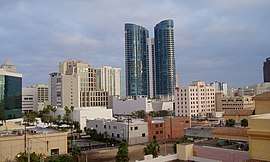
Fort Lauderdale's economy has diversified over time. From the 1940s through the 1980s, the city was known as a spring break destination for college students.[68] The college crowd has since dwindled, however, with the city now attracting wealthier tourists.[69] Cruise ships and nautical recreation provide the basis for much of the revenue raised by tourism. There is a convention center west of the beach and southeast of downtown, with 600,000 square feet (55,742 m2) of space, including a 200,000-square-foot (18,581 m2) main exhibit hall.[70] Approximately 30% of the city's 10 million annual visitors attend conventions at the center.[71]
The downtown area, especially around Las Olas Boulevard, first underwent redevelopment starting in 2002[72] and now hosts many new hotels and high-rise condominium developments.[73] The city's central business district is the largest downtown in Broward County, although there are other cities in the county with commercial centers. Office buildings and highrises include Las Olas River House, Las Olas Grand, 110 Tower (formerly AutoNation Tower), Bank of America Plaza, One Financial Plaza, Broward Financial Center, One East Broward Boulevard, Barnett Bank Plaza, PNC Center, New River Center, One Corporate Center, SunTrust Centre, 101 Tower, and SouthTrust Tower.[74]
The Fort Lauderdale metropolitan area foreclosures increased 127.4% from 2006 to 2007, or one filing per 48 households in the quarter. Fort Lauderdale ranks fourth in the list of top 10 metropolitan areas ranked by foreclosure filings per household for the third quarter of 2007.[75]
Fort Lauderdale is a major manufacturing and maintenance center for yachts. The boating industry is responsible for over 109,000 jobs in the county.[76] With its many canals, and proximity to the Bahamas and Caribbean, it is also a popular yachting vacation stop, and home port for 42,000 boats, and approximately 100 marinas and boatyards.[28] Additionally, the annual Fort Lauderdale International Boat Show, the world's largest[77] boat show, brings over 125,000 people to the city each year.[78][79]
Companies based in the Fort Lauderdale area include AutoNation, Citrix Systems, Commcare Pharmacy, DHL Express, KEMET Corporation, SEACOR Holdings, Spirit Airlines, and National Beverage Corporation. The largest employers in the county are Tenet Healthcare, which employs 5,000 people; American Express, which employs 4,200; FirstService Residential, which employs 3,900; Motorola, which employs 3,000, and Maxim Integrated Products, which employs 2,000.[80]
Gulfstream International Airlines, a commuter airline, is headquartered in nearby Dania Beach.[81][82][83]
Fort Lauderdale was recently listed as 2017's third best city out of 150 U.S. cities by WalletHub for summer jobs, and the 24th best city to start a career in.[84]
Arts and culture
Like many parts of Florida, the city's population has a strong seasonal variation, as snowbirds from the northern United States, Canada, and Europe spend the winter and early spring in Florida.[85] The city is known for its beaches, bars, nightclubs, and history as a spring break location, back in the 1960s and 1970s, for tens of thousands of college students.[86] The city has discouraged college students from visiting the area since the mid-1980s, however, by passing strict laws aimed at preventing the mayhem that occurred in the 1970s and 1980s.[68] The city had an estimated 350,000 college visitors for spring break 1985;[87] by 1989, that number had declined to about 20,000.[68] Since the 1990s, Fort Lauderdale has increasingly catered to those seeking the resort lifestyle seasonally or year-round and is often a host city to many professional venues, concerts, and art shows.
Fort Lauderdale's arts and entertainment district, otherwise known as the Riverwalk Arts & Entertainment District, runs east–west along Las Olas Boulevard, from the beach to the heart of downtown. The district is anchored in the West by the Broward Center for the Performing Arts, and runs through the city to the intersection of Las Olas and A1A. This intersection is the "ground zero" of Fort Lauderdale Beach, and is the site of the Elbo Room bar featured in the 1960 film Where the Boys Are, which led in large measure to the city's former reputation as a spring break mecca.[68] The city and its suburbs host over 4,100 restaurants and over 120 nightclubs, many of them in the arts and entertainment district.[28] The city is also the setting for the 1986 movie Flight of the Navigator, and host of Langerado, an annual music festival. In 2013, the county welcomed about 1.3 million LGBT travelers who spent about $1.5 billion in area restaurants, hotels, attractions and shops, according to the Greater Fort Lauderdale Convention & Visitors Bureau.
Sites of interest
Hugh Taylor Birch State Park is a 180-acre (0.73 km2) park along the beach, with nature trails, camping and picnicking areas, canoeing, and features the Terramar Visitor Center, with exhibits about the ecosystem of the park.[88] Hugh Taylor Birch came to Florida in 1893. He purchased ocean-front property for about a dollar per acre, he eventually owned a 3.5-mile stretch of beachfront.[89] The Bonnet House is a historic home in Fort Lauderdale, Florida, United States. Bonnet House's modern history began when Birch gave the Bonnet House property as a wedding gift to his daughter Helen and her husband, Chicago artist Frederic Clay Bartlett in 1919. The site was listed on the National Register of Historic places in 1984 and declared a historic landmark by the City of Fort Lauderdale in 2002.[90]
Henry E. Kinney Tunnel on U.S. Route 1 is the only tunnel on a state road in the state of Florida.[91] It was constructed in 1960, and its 864-foot (263 m) length travels underneath the New River and Las Olas Boulevard.
Just minutes from the beach is the Riverwalk Arts and Entertainment District in downtown Fort Lauderdale, home to cultural attractions, shops, parks and restaurants. Along Riverwalk, the brick-lined meandering promenade, discover the Broward Center for the Performing Arts, Museum of Discovery and Science with its AutoNation 3D IMAX Theater, Florida Grand Opera, Fort Lauderdale Historical Center, Stranahan House and the Museum of Art.[92]
Las Olas Boulevard is a popular thoroughfare in downtown Fort Lauderdale that runs from Andrews Avenue in the Central Business District to A1A and Fort Lauderdale Beach. The boulevard is a popular attraction for locals and visitors, being ideally situated close to Fort Lauderdale beach, Fort Lauderdale-Hollywood International Airport and Port Everglades. It is considered to be South Florida's most architecturally unique, authentic, and eclectic shopping and dining district.[93]
In addition to its museums, beaches, and nightlife,[94] Fort Lauderdale is home to: the Fort Lauderdale Swap Shop, a large indoor/outdoor flea market and the site of the world's largest drive-in movie theater, with 13 screens,[95] North Woodlawn Cemetery, an African-American cemetery east of Interstate 95 near Sunrise Boulevard, was added to the National Register of Historic Places in 2017,[96] Calvary Chapel Fort Lauderdale, an evangelical megachurch in Fort Lauderdale[97] and the annual Fort Lauderdale International Boat Show,[98] where almost 500 boats, yachts and mega yachts are on display.[99]
Historic structures
The following are images of some of the remaining historical structures in Fort Lauderdale. Some are listed in the National Register of Historic Places:[100][101][102]
 The Bonnet House was built in 1895 and is at 900 Birch Road. In 1919, the owner, Hugh Taylor Birch, gave the property to his daughter Helen and artist Frederic Clay Bartlett as a wedding gift. The property was listed in the National Register of Historic Places on July 5, 1984; reference #84000832.
The Bonnet House was built in 1895 and is at 900 Birch Road. In 1919, the owner, Hugh Taylor Birch, gave the property to his daughter Helen and artist Frederic Clay Bartlett as a wedding gift. The property was listed in the National Register of Historic Places on July 5, 1984; reference #84000832.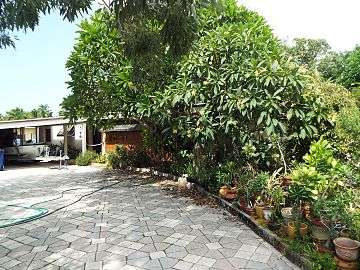 The Dr. Willard Van Orsdel King House was built in 1951 and is at 1336 Seabreeze Boulevard. In February 21, 2006, it was listed in the National Register of Historic Places; reference #06000059.
The Dr. Willard Van Orsdel King House was built in 1951 and is at 1336 Seabreeze Boulevard. In February 21, 2006, it was listed in the National Register of Historic Places; reference #06000059.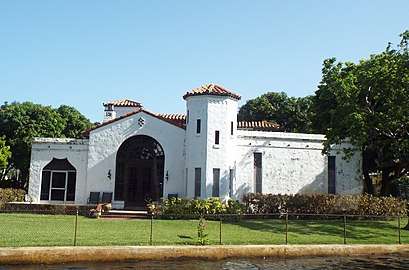 The Benjamin "Bugsy" Siegel House in Fort Lauderdale, Florida along the riverside of New River. This was the residence of the infamous mobster known as Bugsy Seigel.
The Benjamin "Bugsy" Siegel House in Fort Lauderdale, Florida along the riverside of New River. This was the residence of the infamous mobster known as Bugsy Seigel.
Sports
Lockhart Stadium in Fort Lauderdale, was the home of the Fort Lauderdale Strikers, which played in the most recent incarnation of the North American Soccer League. It was the home of the original Fort Lauderdale Strikers, which played in the previous version of the North American Soccer League. The Miami Fusion of Major League Soccer played home games at this stadium from 1998 to 2001. The Florida Atlantic University Owls football team played its home games at Lockhart Stadium from 2003 through 2010.[103][104]
The New York Yankees, Baltimore Orioles, and Kansas City Royals used to conduct spring training in the city at Fort Lauderdale Stadium.[105]
Fort Lauderdale is also home to the Fort Lauderdale Aquatic Complex, which is at the International Swimming Hall of Fame. It contains two 25-yard (23 m) by 50-meter competition pools, as well as one 20 by 25-yard (23 m) diving well. The complex is open to Fort Lauderdale residents, and has also been used in many different national and international competitions since its opening in 1965. 10 world records have been set there, from Catie Ball's 100 m breaststroke in 1966[106] to Michael Phelps' 400 m individual medley in 2002.[107]
War Memorial Auditorium has hosted professional wrestling, boxing and mixed martial arts shows since its opening in 1950. In 2019, the Florida Panthers signed a 50-year lease with the venue with plans to renovate it and add hockey facilities.[108]
Government
Fort Lauderdale has a Commission-Manager form of government. City policy is set by a city commission of five elected members: the mayor and four district commission members. In 1998, the municipal code was amended to limit the mayoral term. The mayor of Fort Lauderdale now serves a three-year term and cannot serve more than three consecutive terms.[109] The current mayor is Dean Trantalis, who succeeded Jack Seiler in 2018. The longest-serving mayor is Jim Naugle, who served from 1991 to 2009.[110] Administrative functions are performed by a city manager, who is appointed by the city commission. Fort Lauderdale Fire-Rescue Department provides Fire and Emergency Medical Services.
Federal representation
The United States Postal Service operates post offices in Fort Lauderdale. The Fort Lauderdale Main Post Office is at 1900 West Oakland Park Boulevard in the city of Oakland Park.[111] Post offices within the city limits include Alridge,[112] Colee,[113] Coral Ridge,[114] Gateway Station,[115] Melrose Vista,[116] and Southside Station.[117]
Education
According to 2000 census data, 79.0% of the city's population aged 25 or older were high school graduates, slightly below the national figure of 80.4%. 27.9% held at least a baccalaureate, slightly higher than the national figure of 24.4%. Broward County Public Schools operates 23 public schools in Fort Lauderdale. 2007 Florida Comprehensive Assessment Test (FCAT) results for Fort Lauderdale's public schools were mixed; while ten (of sixteen) elementary schools and one (of four) middle schools received "A" or "B" grades, Sunland Park Elementary School[118] and Arthur Ashe Middle School[119] received failing grades. Boyd Anderson High School, which is in Lauderdale Lakes but whose attendance zone includes part of Fort Lauderdale, also received a failing grade.[120] None of the three failing schools have failed twice in a four-year period, thus triggering the "Opportunity Scholarship Program" school choice provisions of the Florida's education plan.[121]
Ten institutions of higher learning have main or satellite campuses in the city:
- The Art Institute of Fort Lauderdale
- Broward College BC (Willis Holcombe Downtown Center)
- City College
- Embry-Riddle Aeronautical University (satellite campus)
- Florida Atlantic University FAU (satellite campus)
- Florida International University FIU (satellite campus)
- Keiser University
- Jersey College
- Nova Southeastern University NSU (satellite campus)
- University of Phoenix (Cypress Creek Learning Center)
Additionally, the Davenport, Iowa-based Kaplan University's Corporate headquarters and an academic support center are in the city.[122]
Media
Fort Lauderdale is served by English-language newspapers South Florida-Sun Sentinel and The Miami Herald, Spanish-language newspapers El Sentinel, El Nuevo Herald and an alternative newspaper New Times Broward-Palm Beach.
Infrastructure
Transportation
Transit
Broward County Transit (BCT), the county bus system, provides local bus transportation. BCT provides for connections with the bus systems in other parts of the metropolitan area: Metrobus in Dade County and Palm Tran in Palm Beach County. Tri-Rail, a commuter rail system, connects south Florida's major cities and airports. In November 2006, Broward County voters rejected[123] a one-cent-per-hundred sales tax increase intended to fund transportation projects such as light rail and bus system expansion.[124]
The Wave (streetcar), a new 2.7-mile (4.3 km) electric streetcar system costing $125 million, was being planned for the downtown. Most of the construction funding would have come from federal ($62.5 million), state ($37 million) and city taxpayers ($10.5 million), with approximately $15 million from assessments on properties within the Downtown Development Authority. Broward County (BCT) had committed to operating the system for the first 10 years at an expected annual cost of $2 million, and had guaranteed funding to cover any shortfall in ridership revenues.[125] The construction cost of $50 million per mile was considerably higher than other recently built streetcar projects, in part due to the challenges of building an electric transit system over the 3rd Avenue drawbridge. The project was canceled in 2018 by the City and the County.[126]
Regional railroad and commuter railroad
Virgin Trains USA also has a station in Fort Lauderdale, which connects to Miami and West Palm Beach. Plans are underway to extend the line beyond West Palm Beach to Orlando and possibly to the Treasure Coast.
Tri-Rail provides commuter service between Palm Beach County, Broward County (including two stations in Fort Lauderdale, including the Fort Lauderdale station), and Miami-Dade County.
Freight and long distance passenger railroad
Florida East Coast Railway (FEC) and CSX Transportation are freight lines. Amtrak provides passenger service, Silver Meteor and Silver Star to other cities on the Atlantic coast via the Fort Lauderdale station.
Airports
Fort Lauderdale-Hollywood International Airport, near Dania Beach, Florida, is the city's main airport and is the fastest-growing major airport in the country.[127] This is, in part, attributable to service by low-cost carriers such as Spirit Airlines, JetBlue Airways, Southwest Airlines and Silver Airways, resulting in lower airfares than nearby Miami International Airport.[128] Fort Lauderdale-Hollywood is an emerging international gateway for the Caribbean and Latin America. Miami International Airport and Palm Beach International Airport also serve the city.
Waterways
Fort Lauderdale is home to Port Everglades, the nation's third busiest cruise port.[129] It is Florida's deepest port, and is an integral petroleum receiving point.[130] Fort Lauderdale is served by a regular international passenger ferry service to Freeport, Grand Bahama Island, Bahamas operated by Baleària Bahamas Express.
Roads

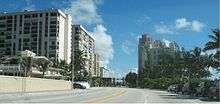
Broward County is served by three major Interstate Highways (I-75, I-95, I-595) and U.S. Highways such as U.S. 1, US 27 and US 441. The interchange between I-95 and I-595/SR 862 is known as the Rainbow Interchange. It is also served by Florida's Turnpike and State Highway 869, also known as the Sawgrass Expressway.
Healthcare
Fort Lauderdale is served by Broward General Medical Center and Imperial Point Medical Center, which are operated by Broward Health, the third largest hospital consortium in the United States. Broward General is a 716-bed[131] acute care facility that is designated as a Level I trauma center.[132] It is also home to Chris Evert Children's Hospital and a Heart Center of Excellence. The hospital serves as a major training site for medical students from Nova Southeastern University's College of Osteopathic Medicine, as well as nursing and paramedic programs from throughout the area. Imperial Point Medical Center is a 204-bed facility[131] with a hyperbaric medicine program.[133] Holy Cross Hospital, a 571-bed[134] hospital operated by the Sisters of Mercy, was named by HealthGrades as one of the 50 best hospitals in the country for 2007.[135]
See also
- List of people from Fort Lauderdale, Florida
- List of sister cities of Fort Lauderdale, Florida
- List of tallest buildings in Fort Lauderdale
References
- Mean monthly maxima and minima (i.e. the highest and lowest temperature readings during an entire month or year) calculated based on data at said location from 1981 to 2010.
- "City of Fort Lauderdale, FL: Vice Mayor Ben Sorensen". www.fortlauderdale.gov. Archived from the original on 2019-03-02. Retrieved 2019-03-01.
- "Municipal Directory: City of Fort Lauderdale". www.floridaleagueofcities.com. Archived from the original on 2019-03-01. Retrieved 2019-03-01.
- "City of Fort Lauderdale, FL: City Commission". www.fortlauderdale.gov. Retrieved 2019-03-01.
- "ABOUT THE CITY MANAGER'S OFFICE". www.fortlauderdale.gov. Retrieved 2019-03-01.
- "ABOUT THE CITY CLERK'S OFFICE". www.fortlauderdale.gov. Retrieved 2019-03-01.
- "2019 U.S. Gazetteer Files". United States Census Bureau. Retrieved July 2, 2020.
- "Fort Lauderdale, United States Page". Falling Rain Genomics. Retrieved 2007-09-23.
- "Population and Housing Unit Estimates". Retrieved May 21, 2020.
- "Fort Lauderdale, Florida Zip Code Boundary Map (FL)". Retrieved 15 February 2015.
- "US Board on Geographic Names". United States Geological Survey. 2007-10-25. Retrieved 2008-01-31.
- "U.S. Census Bureau QuickFacts: Fort Lauderdale city, Florida". www.census.gov.
- "U.S. Census Bureau QuickFacts: Miami-Dade County, Florida; Broward County, Florida; Palm Beach County, Florida". www.census.gov.
- "2018 Tourism Tidbits - Quick reference card". market research. Greater Fort Lauderdale Convention & Visitors Bureau. Retrieved 19 November 2019.
- "2012 Year-End Statistics". Greater Fort Lauderdale Convention & Visitors Bureau. 2013-01-09. Archived from the original on 2013-06-05. Retrieved March 1, 2014.
- "Old Fort Lauderdale Museum-Sneak Preview". Fort Lauderdale Historical Society. Archived from the original on April 23, 2003. Retrieved 2007-07-17.
- Hughes, Kenneth J (1993). "Three Tequesta and Seminole hunting camps on the edge of the Everglades" (PDF). Broward Legacy (Broward County Historical Commission). 16 (3 and 4). pp. 31–42. Retrieved 2007-07-01.
- McGoun, Bill (1978). "A History of Broward County" (PDF). Broward Legacy (Broward County Historical Commission). 2 (3 and 4). pp. 15–22. Retrieved 2007-07-03.
- "Coastal History – The Seminole War Period". Vone Research. Archived from the original on September 28, 2007. Retrieved 2007-07-21.
- Butler, Stuart (1981). "Records in the Military Archives Division Which Relate to South Florida" (PDF). Broward Legacy (Broward County Historical Commission). 4 (1 and 2). pp. 11–20. Retrieved 2007-07-15.
- "The Creation of Broward County: Victory in Tallahassee" (PDF). Broward Legacy (Broward County Historical Commission). 11 (3 and 4). 1988. pp. 6–8. Retrieved 2007-07-02.
- Kirk, Cooper (1985). "Foundations of Broward County Waterways" (PDF). Broward Legacy (Broward County Historical Commission). 8 (1 and 2). pp. 2–18. Retrieved 2007-07-14.
- "Top 10 Weather Events-Broward County". National Oceanic and Atmospheric Administration. Archived from the original on April 18, 2008. Retrieved 2007-07-01.
- "Negro is Lynched by Mob in Florida". New York Times. 20 July 1935.
- "Nazi Press Scorns U.S. on Lynch Horrors". The Pittsburgh Courier. 10 August 1935.
- George, Paul S. (1991). "Submarines and Soldiers: Fort Lauderdale in World War II" (PDF). Broward Legacy (Broward County Historical Commission). 14 (1 and 2). pp. 2–14. Retrieved 2007-07-05.
- Crawford, Jr., William G. (2007). "The Long Hard Fight for Equal Rights: A History of Broward County's Colored Beach and the Fort Lauderdale Beach 'Wade-ins' of the Summer of 1961" (PDF). Tequesta. 67. pp. 19–49.
- Deborah Work, My Soul Is a Witness: A History of Black Fort Lauderdale, pp. 138-48
- "Greater Fort Lauderdale 2006 Statistics" (Press release). Greater Fort Lauderdale Convention and Visitors Bureau. March 2007. Archived from the original on 2007-09-29. Retrieved 2007-07-18.
- "Annual Estimates of the Population of Metropolitan and Micropolitan Statistical Areas: April 1, 2000 to July 1, 2007" (XLS). U.S. Census Bureau. Retrieved 2008-07-11.
- "Census of Population:1960 Florida-Volume I Part 11" (PDF). United States Census Bureau. pp. 11–9. Retrieved 2007-07-01.
- George, Paul S. (1991). "Downtown Fort Lauderdale: Its Demise and Renaissance in the Post-War Era" (PDF). Broward Legacy (Broward County Historical Commission). 14 (3 and 4). pp. 9–19. Retrieved 2007-07-17.
- "1970 Census of Population" (PDF). United States Census Bureau. pp. 11–12. Retrieved 2007-07-01.
- "1980 Census of Population" (PDF). United States Census Bureau. pp. 11–20. Retrieved 2007-07-01.
- "Broward by the Numbers:Unincorporated Broward" (PDF). Broward County Planning Services Division. December 2005. Archived from the original (PDF) on August 10, 2007. Retrieved 2007-07-15.
- "Geographic Identifiers: 2010 Demographic Profile Data (G001): Fort Lauderdale city, Florida". U.S. Census Bureau, American Factfinder. Archived from the original on February 12, 2020. Retrieved October 22, 2013.
- "About Fort Lauderdale". City of Fort Lauderdale. Archived from the original on 2007-08-07. Retrieved 2007-07-17.
- "Fort Lauderdale Beach". City of Fort Lauderdale. Archived from the original on 2007-07-05. Retrieved 2007-07-17.
- "Tire reef off Florida proves a disaster". Associated Press. February 16, 2007. Retrieved 2007-06-21.
- Loney, Jim (July 9, 2007). "Florida raises ill-fated artificial reefs". Reuters. Retrieved 2007-07-10.
- "Neighborhood Organization Recognition Program". City of Fort Lauderdale. Archived from the original on 2013-06-23. Retrieved 2013-06-24.
- "Neighborhood Associations" (PDF). City of Fort Lauderdale. Archived from the original (PDF) on 2014-07-01. Retrieved 2013-06-24.
- Tropicalité Géographie physique intertropicale by Jean Demangeot, éditions Armand Colin, Paris, 1999? ISBN 2-200-25027-4, page 44, Figure 19 Génétique des climats intertropicaux, source Marcel Leroux 1989
- "Climate Fort Lauderdale". Climate-Data,org. Retrieved November 8, 2018.
- "Historical Weather for Fort Lauderdale, Florida, United States of America – Travel, Vacation and Reference Information". Weatherbase. Retrieved 2011-06-09.
- "Fort Lauderdale-Hollywood International Airport Equals All Time High Temperature Record June 22; Daily Records Fall at Miami and West Palm Beach" (PDF). National Oceanic and Atmospheric Administration. Retrieved June 9, 2011.
- Lardner Jr., George; Meyers, Robert. "Miami Is Hit by First Recorded Snow: State of Emergency Is Eyed for Virginia Thousands Idled as Cold Closes Factories, Businesses". The Washington Post. January 20, 1977. p. A1. "It also snowed in Fort Lauderdale, Palm Beach, Fort Myers, and yes, even in the Bahamas."
- South Florida Sun-Sentinel (Fort Lauderdale, Fla.) January 19, 2007.
- "Frequently Asked Questions- When are major hurricanes likely to strike different states?". Atlantic Oceanographic and Meteorological Laboratory. Retrieved 2007-07-21.
- Shapiro, Len (September 11, 2017). "Fort Lauderdale picks up after Irma". The Washington Post. Retrieved October 4, 2019.
- "NOWData – NOAA Online Weather Data". National Oceanic and Atmospheric Administration. Retrieved 2020-07-24.
- "Station Name: FL FT LAUDERDALE HOLLYWOOD AP". National Oceanic and Atmospheric Administration. Retrieved 2020-07-24.
- "CLIMATOLOGICAL RECORDS FOR FORT LAUDERDALE, FL" (PDF). NWS Miami-South Florida. Retrieved 13 April 2018.
- United States Census Bureau. "Census of Population and Housing". Retrieved November 18, 2013.
- "Fort Lauderdale, Florida Hispanic or Latino by Type: 2010 - 2010 Census Summary File 1". United States Census Bureau. Retrieved October 26, 2015.
- "Fort Lauderdale, Florida Profile of General Population and Housing Characteristics: 2010 - 2010 Demographic Profile Data". United States Census Bureau. Retrieved October 26, 2015.
- "Fort Lauderdale, Florida: SELECTED SOCIAL CHARACTERISTICS IN THE UNITED STATES - 2006-2010 American Community Survey 5-Year Estimates". United States Census Bureau. Retrieved October 26, 2015.
- "Fort Lauderdale, Florida: Age Groups and Sex: 2010 - 2010 Census Summary File 1". United States Census Bureau. Retrieved October 26, 2015.
- "Fort Lauderdale, Florida: SELECTED ECONOMIC CHARACTERISTICS - 2006-2010 American Community Survey 5-Year Estimates". United States Census Bureau. Retrieved October 26, 2015.
- "Ancestry Map of Haitian Communities". Epodunk.com. Archived from the original on 2012-12-11. Retrieved 2007-10-22.
- "Ancestry Map of Cuban Communities". Epodunk.com. Retrieved 2007-10-22.
- "Modern Language Association Data Center Results of Broward County, Florida". Modern Language Association. Retrieved 2007-06-21.
- "Modern Language Association Data Center Results, Fort Lauderdale, Florida". Modern Language Association. Archived from the original on October 12, 2007. Retrieved 2007-06-21.
- The Miami Herald. "Steve Rothaus' Gay South Florida". Miamiherald.typepad.com. Retrieved 2012-12-18.
- Ost, Jason. "Facts and Findings from The Gay and Lesbian Atlas". Urban.org. Retrieved 2012-12-18.
- Lee, Gary (15 May 2005). "Where the Boys Are, Part 2: Watch out, South Beach. Fort Lauderdale is making its moves as a top gay spot". The Washington Post. Retrieved 2 September 2010.
- "Hotels « Categories « Gay Fort Lauderdale Guide Gay Ft. Lauderdale Hotels". Gayftlauderdale.com. Retrieved 2017-01-23.
- Burke, Peter (2018-03-14). "Dean Trantalis makes history as first openly gay mayor of Fort..." www.local10.com. Retrieved 2018-10-16.
- George, Paul S. (1991). "Where the boys were" (PDF). South Florida History Magazine (1). Historical Association of Southern Florida. pp. 5–8. Archived from the original (PDF) on 13 March 2016. Retrieved 16 November 2017 – via HistoryMiami.
- "Fort Lauderdale Travel Guide". Fodor's. Retrieved 2007-06-21.
- "Fact Sheet-Greater Fort Lauderdale/Broward County Convention Center". Greater Fort Lauderdale Convention and Visitors Bureau. Archived from the original on 2007-09-29. Retrieved 2007-07-18.
- "Fall 2006 newsletter:The Way We Were" (PDF) (Press release). Greater Fort Lauderdale/Broward County Convention Center. Fall 2006. Archived from the original (PDF) on 2007-08-10. Retrieved 2007-07-18.
- "Las Olas Boulevard needs help, yet Mayor Seiler does nothing". A Better Fort Lauderdale: New Visions for Our City. Archived from the original on 2013-07-24. Retrieved 3 October 2012.
- Owers, Paul. "Developers look to revive stretch of New River in Fort Lauderdale". Sun Sentinel. Retrieved 3 October 2012.
- "SkyscraperPage.com". Retrieved September 2, 2010. Other improvements include a wide array of new boutiques, art galleries, and restaurants.
- "Report: Fort Lauderdale, Miami high in foreclosures per household". South Florida Business Journal. November 14, 2007. Retrieved 2007-11-24.
- Cantanese Center for Urban and Environmental Studies (January 2005). "Interim Boat Facility Siting Plan" (PDF). Draft. Broward County Environmental Protection Department: 38. Archived from the original (PDF) on August 10, 2007. Retrieved 2007-07-22. Cite journal requires
|journal=(help) - "World's Largest Boat Show Opens amid Cautious Optimism". Business Wire. 2011-10-26. Retrieved 3 October 2012.
- Visitor numbers Archived July 26, 2010, at the Wayback Machine, International Federation of Boat Show Organisers (IFBSO)
- "47th Annual Fort Lauderdale International Boat Show". City of Fort Lauderdale. Archived from the original on 2007-09-29. Retrieved 2007-07-22.
- "Largest Employers in Broward County" (PDF). The Broward Alliance. Archived from the original (PDF) on August 10, 2007. Retrieved 2007-07-22.
- "Dania Beach city, Florida Archived August 26, 2009, at the Wayback Machine." U.S. Census Bureau. Retrieved on May 21, 2009.
- "Contact Us". 19 April 2009. Archived from the original on 19 April 2009.
- Pasztor, Andy and Susan Carey. "Gulfstream Faces Penalty on Pilot Hours, Maintenance." The Wall Street Journal. May 21, 2009. Retrieved on May 21, 2009.
- "Fort Lauderdale Ranks High on WalletHub's Lists of Best Places Jobs".
- Lawlor, Julia (2 February 2007). "Snowbirds flock together for winter". The New York Times. Retrieved 16 July 2007.
- Marsh, Bill (19 March 2006). "The innocent birth of the spring bacchanal". The New York Times. Retrieved 13 May 2007.
- Weber, Janelle (30 March 2001). "Fort Lauderdale says goodbye to wild, youthful spring breaks". Associated Press. Archived from the original on 27 September 2007. Retrieved 15 July 2007.
- "Florida State Parks—Hugh Taylor Birch State Recreation Area". Florida Division of Recreation and Parks. Retrieved 2007-07-23.
- "Florida State Parks". Florida State Parks. Retrieved 2017-01-23.
- "Ft. Lauderdale Bonnet House Museum and Gardens Historic Estate History". Bonnethouse.org. 2014-06-20. Retrieved 2017-01-23.
- "KidZone—Henry E. Kinney Tunnel". Florida State Department of Transportation. Archived from the original on November 2, 2007. Retrieved 2007-07-23.
- "Things to Do in Fort Lauderdale | Attractions, Shopping & Tours". Sunny.org. 1970-01-01. Retrieved 2017-01-23.
- "Official Website of Las Olas BoulevardLas Olas Boulevard". Lasolasboulevard.com. Retrieved 2017-01-23.
- "Editors' Picks: The Ultimate Guide To Fort Lauderdale's Restaurants, Venues And More". Fort Lauderdale Daily. Retrieved 2019-08-08.
- Rowe, Sean (November 5, 1998). "The Sultan of Swap". Miami New Times. Retrieved 2007-07-23.
- Sweeney, Dan (December 21, 2017). "Fort Lauderdale African-American cemetery added to historic register". Sun-Sentinel.
- "Calvary Chapel Fort Lauderdale". Hartford Institute for religion research. Retrieved September 21, 2019.
- "Boat Show". Sun-Sentinel. September 21, 2019. Retrieved September 21, 2019.
- "Fort Lauderdale International Boat Show - Boats on Display". Informa. Retrieved September 21, 2019.
- "National Register of Historical Places - FLORIDA (FL), Broward County". Nationalregisterofhistoricplaces.com. Retrieved 2017-01-23.
- "Haus von Bugsy Siegel - Picture of Carrie B Cruises, Fort Lauderdale". TripAdvisor. 2013-06-16. Retrieved 2017-01-23.
- McCaughan, Sean (2013-06-24). "And Now, The 38 Essential Miami/South Florida Hotels - Curbed Miami". Miami.curbed.com. Retrieved 2017-01-23.
- "Lockhart Stadium". South Florida Sun-Sentinel. Retrieved 3 December 2011.
- Harwitt, Sandra (October 23, 2011). "New FAU stadium can't help winless Owls". Miami Herald. Retrieved 3 December 2011.
- "Spring Training:Ballpark Information". Baltimore Orioles/Major League Baseball. Retrieved 2007-10-20.
- "Recordhistorie Wereldrecords dames(50m):100 meter schoolslag" (in Dutch). Zwemkroniek. Retrieved 2007-12-05.
- "Recordhistorie Wereldrecords heren (50m):400 meter wisselslag" (in Dutch). Zwemkroniek. Retrieved 2007-12-05.
- https://www.sportsbusinessdaily.com/Daily/Issues/2019/10/18/Facilities/NHL-Panthers.aspx
- "Fort Lauderdale Municipal Code Sec. 3.02. Creation, composition and term of commission". Municipal Code Corporation. Retrieved 2007-07-23.
- "Mayor Jim Naugle". City of Fort Lauderdale. Archived from the original on 2007-08-10. Retrieved 2007-07-20.
- "OAKLAND PARK Post Office". Archived from the original on 2013-02-09.
- "ALRIDGE Post Office™ Location". 17 July 2012. Archived from the original on 17 July 2012.
- "COLEE Post Office™ Location". 17 July 2012. Archived from the original on 17 July 2012.
- "CORAL RIDGE Post Office™ Location". 18 July 2012. Archived from the original on 18 July 2012.
- "GATEWAY Post Office™ Location". 15 July 2012. Archived from the original on 15 July 2012.
- "MELROSE VISTA Post Office™ Location". 15 July 2012. Archived from the original on 15 July 2012.
- "SOUTHSIDE Post Office™ Location". 17 July 2012. Archived from the original on 17 July 2012.
- "FCAT School Grades—Elementary". Broward County Public Schools. Archived from the original on 2004-06-18. Retrieved 2007-07-23.
- "FCAT School Grades—Middle". Broward County Public Schools. Archived from the original on 2004-06-18. Retrieved 2007-07-23.
- "FCAT School Grades—High". Broward County Public Schools. Archived from the original on 2004-06-18. Retrieved 2007-07-23.
- "Opportunity Scholarship Program". Florida Department of Education. Archived from the original on 2007-07-26. Retrieved 2007-07-23.
- "Newsroom". Kaplan. Archived from the original on November 20, 2008. Retrieved August 31, 2010.
- "2006 Elections-Funding for county-wide transportation improvements". Broward County Supervisor of Elections. Archived from the original on 2007-09-28. Retrieved 2007-07-21.
- Fierro, David (October 10, 2006). "Broward county voters will vote on transit tax Nov. 7". Florida Transportation Monthly. Retrieved 2007-07-21.
- "The Wave homepage". The Wave. Archived from the original on 2016-01-21.
- Barszewski, Larry (May 8, 2018). "Broward follows Fort Lauderdale to end Wave streetcar project". South Florida Sun Sentinel. Retrieved January 4, 2020.
- "Orlando surpasses Miami as Florida's busiest airport". Associated Press. February 15, 2005. Retrieved 2007-10-20.
- Maynard, Micheline (January 2, 2005). "Lower fares shift traffic to less-used airports". The New York Times. Retrieved 2007-06-20.
- "Port Everglades". Broward County, Florida. Retrieved 2007-07-17.
- "Port Everglades-Petroleum". Broward County, Florida. Archived from the original on August 6, 2007. Retrieved 2007-07-17.
- "Quick Facts". North Broward Hospital District. Archived from the original on September 27, 2007. Retrieved 2007-07-20.
- "BGMC Services". North Broward Hospital District. Archived from the original on September 27, 2007. Retrieved 2007-07-20.
- "Center for Wound Care & Hyperbaric Medicine". North Broward Hospital District. Archived from the original on September 27, 2007. Retrieved 2007-07-21.
- "History of Holy Cross Hospital". Holy Cross Hospital. Archived from the original on September 29, 2007. Retrieved 2007-07-21.
- "HealthGrades-America's 50 Best Hospitals". HealthGrades, Inc. Archived from the original on 2007-09-28. Retrieved 2007-07-21.

